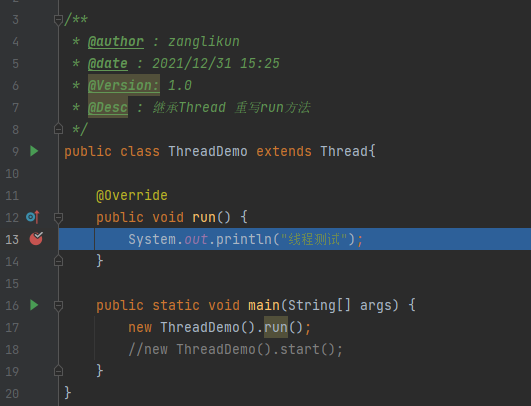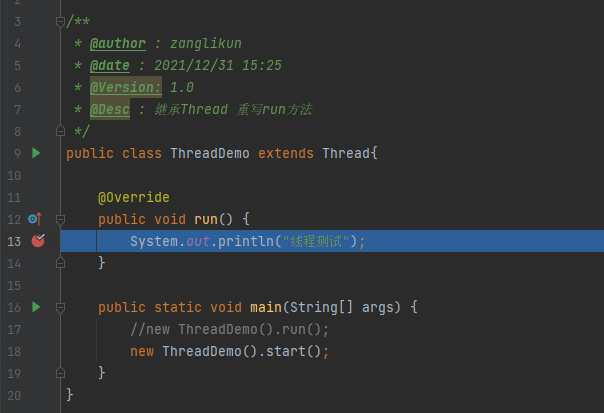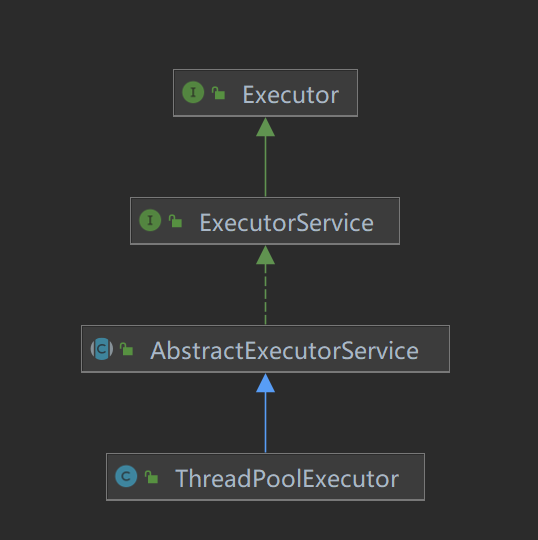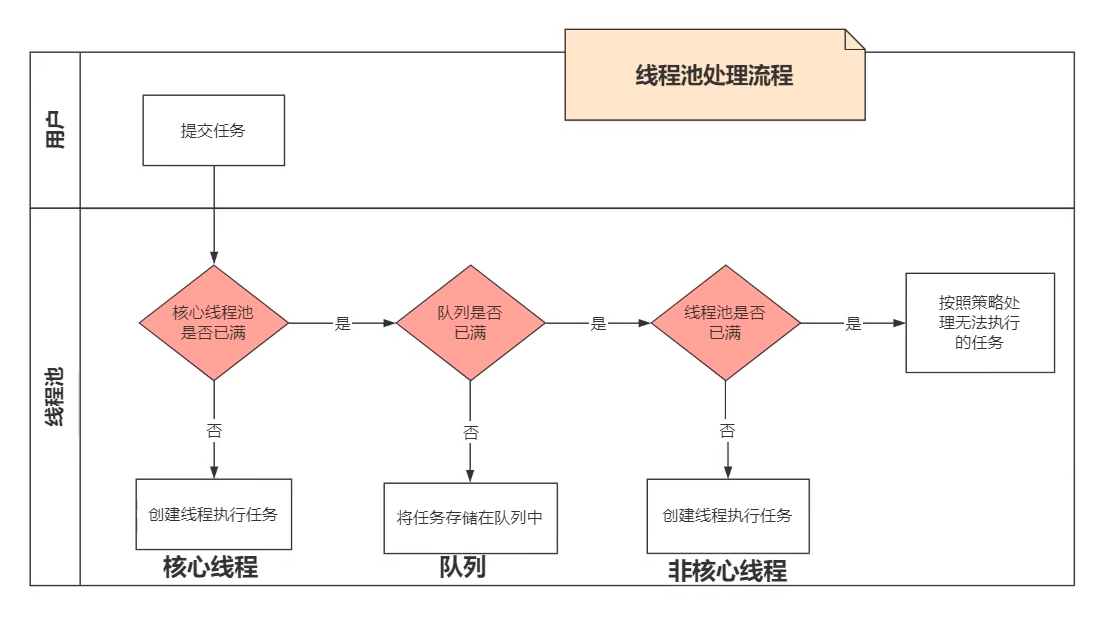快速导航
测试3种线程池执行效率 以及原因
猜测一下,打印的“线程测试”的两个方法 那个是多线程执行的?
/**
* @author : zanglikun
* @date : 2021/12/31 15:25
* @Version: 1.0
* @Desc : 继承Thread 重写run方法
*/
public class ThreadDemo extends Thread{
@Override
public void run() {
System.out.println("线程测试");
}
public static void main(String[] args) {
new ThreadDemo().run();
new ThreadDemo().start();
}
}
答案是 start()执行的是多线程的。
我们Debug看一下:
run()方法

进入断点之后点击 照相机(获取线程转储) 就可以看到当前项目的线程信息了!

Start()方法


对比一下,run方法的线程名叫main 而 start方法执行的线程名是 Thread-0@509
在对比一下 单线程与多线程的执行效率
单线程代码
@SneakyThrows
@Test
public void testSingleThread() {
long StartTime = System.currentTimeMillis();
final ArrayList<String> arrayList = new ArrayList();
for (int i = 0; i < 100000; i++) {
Thread thread = new Thread() {
@Override
public void run() {
arrayList.add("abcdfg");
}
};
thread.start();
// join()让Thread这个线程 在main线程结束时等待,让其在main线程结束后在结束!
thread.join();
}
long EndTime = System.currentTimeMillis();
System.out.println("消耗了:" + (EndTime - StartTime) / 1000.00 + "秒");
System.out.println(arrayList.size());
}消耗了:25.095秒
100000多线程代码
@SneakyThrows
@Test
public void testMuiltThread() {
long StartTime = System.currentTimeMillis();
final ArrayList<String> arrayList = new ArrayList();
ExecutorService executorService = Executors.newSingleThreadExecutor();
for (int i = 0; i < 100000; i++) {
executorService.execute(() -> {
arrayList.add("abcdfg");
});
}
// 如果不shutdown,那么main方法走完了,直接打印消耗时间、打印集合长度时不准确的。因为main线程结束,线程池的线程还在执行,就打印结果肯定是不准确的
executorService.shutdown();
executorService.awaitTermination(1, TimeUnit.DAYS);
long EndTime = System.currentTimeMillis();
System.out.println("消耗了:" + (EndTime - StartTime) / 1000.00 + "秒");
System.out.println(arrayList.size());
}消耗了:0.05秒
100000测试不同线程池的效率
@SneakyThrows
@Test
public void testDifferentThreadPool() {
long StartTime = System.currentTimeMillis();
final ArrayList<String> arrayList = new ArrayList();
ExecutorService executorService1 = Executors.newCachedThreadPool(); //最快
ExecutorService executorService2 = Executors.newFixedThreadPool(10); //慢大约49倍的执行时间(只在本场景(循环1000次)适用,不是两个线程池的的规范的效率差距)
ExecutorService executorService3 = Executors.newSingleThreadExecutor(); //对比上一个慢了10倍(只在本场景(循环1000次)适用,不是两个线程池的的规范的效率差距)
for (int i = 0; i < 1000; i++) {
executorService1.execute(() -> {
try {
System.out.println("当前线程名称"+Thread.currentThread().getName());
arrayList.add("abcdef");
Thread.sleep(500L);
} catch (InterruptedException e) {
e.printStackTrace();
}
});
}
// 如果不shutdown,那么main方法走完了,直接打印消耗时间、打印集合长度时不准确的。因为main线程结束,线程池的线程还在执行,就打印结果肯定是不准确的
executorService1.shutdown();
executorService1.awaitTermination(1, TimeUnit.DAYS);
long EndTime = System.currentTimeMillis();
System.out.println("消耗了:" + (EndTime - StartTime) / 1000.00 + "秒");
System.out.println(arrayList.size());
}使用不同线程池分别执行一下,结果:
newCachedThreadPool() 0.616秒
打印日志如下:
当前线程名称pool-1-thread-1
当前线程名称pool-1-thread-3
当前线程名称pool-1-thread-2
......
当前线程名称pool-1-thread-997
当前线程名称pool-1-thread-998
当前线程名称pool-1-thread-999
当前线程名称pool-1-thread-1000
... 线程ID 编号取值1-1000
newFixedThreadPool() 50.037秒
打印日志如下:
当前线程名称pool-2-thread-1
当前线程名称pool-2-thread-2
当前线程名称pool-2-thread-3
当前线程名称pool-2-thread-4
当前线程名称pool-2-thread-6
当前线程名称pool-2-thread-5
当前线程名称pool-2-thread-7
当前线程名称pool-2-thread-8
当前线程名称pool-2-thread-10
当前线程名称pool-2-thread-9
... 以此循环线程ID 编号取值1-10 这里就能看到线程复用的提现!
newSingleThreadExecutor() 我预测是500秒,没想到还真是500.306秒
打印日志如下:
当前线程名称pool-3-thread-1
当前线程名称pool-3-thread-1
当前线程名称pool-3-thread-1
... 线程ID 编号取值都是1
三种线程池为什么有这么大的差距?
分别看一下这三种线程池源码的构造方法
public static ExecutorService newCachedThreadPool() {
return new ThreadPoolExecutor(0, Integer.MAX_VALUE, #MAX_VALUE是
60L, TimeUnit.SECONDS,
new SynchronousQueue<Runnable>());
}
public static ExecutorService newFixedThreadPool(int nThreads) {
return new ThreadPoolExecutor(nThreads, nThreads,
0L, TimeUnit.MILLISECONDS,
new LinkedBlockingQueue<Runnable>());
}
public static ExecutorService newSingleThreadExecutor() {
return new FinalizableDelegatedExecutorService
(new ThreadPoolExecutor(1, 1,
0L, TimeUnit.MILLISECONDS,
new LinkedBlockingQueue<Runnable>()));
}
构造方法里核心线程数、最大线程数,也就是前2个参数区别(阻塞队列这里我们忽略不考虑)!造成了这个场景的效率差距!
newCachedThreadPool 最大允许开启21亿个线程处理任务
newFixedThreadPool 最大允许开启10个线程处理(我们上方创建对象传入的10)
newSingleThreadExecutor 最大允许开启1个线程处理任务
所以 对应的结果日志时间上的比例也是如此了
第一次 线程直接处理完毕了,而第二次同期时间才处理了10个 剩余990任务都是阻塞的,所以第一次比第二次早了 990 *0.5睡眠的时间 也就是大约48.5秒
第二次 比第三次线程也多了10倍 所以第二次比第三次消耗的时间的10倍。为什么阿里巴巴开发手册抵触使用Java自带线程池
上面分析了3种Java自带的线程池的效率,发现差距就差距在同时工作的线程数。线程数是CPU的压力。但是如果处理不过来的队列,就会挤压在内存中,就一定有OOM(内存泄漏的问题 Out Of Memory)。
所以就需要使用拒绝策略的线程池。核心就是 BlockingQueue的问题!如果任务来不及处理,且队列满了,此时开始执行拒绝策略,就可以避免OOM的问题!
线程的提交优先级、执行优先级
为什么线程打印的线程ID不按照顺序打印?为什么线程9比线程10执行慢?
当前线程名称pool-2-thread-1
当前线程名称pool-2-thread-2
......
当前线程名称pool-2-thread-7
当前线程名称pool-2-thread-8
当前线程名称pool-2-thread-10
当前线程名称pool-2-thread-9源码分析

ExecutorService子类AbstractExecutorService 子类实现的 submit()
public <T> Future<T> submit(Runnable task, T result) {
if (task == null) throw new NullPointerException();
RunnableFuture<T> ftask = newTaskFor(task, result);
execute(ftask);
return ftask;
}这里可以看到 submit() 调用了execute()
ThreadPoolExecutor IDEA点进去 搜索execute()方法
/**
* Checks if a new worker can be added with respect to current
* pool state and the given bound (either core or maximum). If so,
* the worker count is adjusted accordingly, and, if possible, a
* new worker is created and started, running firstTask as its
* first task. This method returns false if the pool is stopped or
* eligible to shut down. It also returns false if the thread
* factory fails to create a thread when asked. If the thread
* creation fails, either due to the thread factory returning
* null, or due to an exception (typically OutOfMemoryError in
* Thread.start()), we roll back cleanly.
*
* @param firstTask the task the new thread should run first (or
* null if none). Workers are created with an initial first task
* (in method execute()) to bypass queuing when there are fewer
* than corePoolSize threads (in which case we always start one),
* or when the queue is full (in which case we must bypass queue).
* Initially idle threads are usually created via
* prestartCoreThread or to replace other dying workers.
*
* @param core if true use corePoolSize as bound, else
* maximumPoolSize. (A boolean indicator is used here rather than a
* value to ensure reads of fresh values after checking other pool
* state).
* @return true if successful
*/
private boolean addWorker(Runnable firstTask, boolean core) {
retry:
for (;;) {
int c = ctl.get();
int rs = runStateOf(c);
// Check if queue empty only if necessary.
if (rs >= SHUTDOWN &&
! (rs == SHUTDOWN &&
firstTask == null &&
! workQueue.isEmpty()))
return false;
for (;;) {
int wc = workerCountOf(c);
if (wc >= CAPACITY ||
wc >= (core ? corePoolSize : maximumPoolSize))
return false;
if (compareAndIncrementWorkerCount(c))
break retry;
c = ctl.get(); // Re-read ctl
if (runStateOf(c) != rs)
continue retry;
// else CAS failed due to workerCount change; retry inner loop
}
}
boolean workerStarted = false;
boolean workerAdded = false;
Worker w = null;
try {
w = new Worker(firstTask);
final Thread t = w.thread;
if (t != null) {
final ReentrantLock mainLock = this.mainLock;
mainLock.lock();
try {
// Recheck while holding lock.
// Back out on ThreadFactory failure or if
// shut down before lock acquired.
int rs = runStateOf(ctl.get());
if (rs < SHUTDOWN ||
(rs == SHUTDOWN && firstTask == null)) {
if (t.isAlive()) // precheck that t is startable
throw new IllegalThreadStateException();
workers.add(w);
int s = workers.size();
if (s > largestPoolSize)
largestPoolSize = s;
workerAdded = true;
}
} finally {
mainLock.unlock();
}
if (workerAdded) {
t.start();
workerStarted = true;
}
}
} finally {
if (! workerStarted)
addWorkerFailed(w);
}
return workerStarted;
}特别说明
addwork() 检查是否可以根据当前池状态和给定界限(核心或最大值)添加新的工作线程
workQueue.offer() 如果可以在不违反容量限制的情况下立即将指定元素插入此队列
workerCountOf() 查看当前线程池某状态的线程数 /**
* Executes the given task sometime in the future. The task
* may execute in a new thread or in an existing pooled thread.
*
* If the task cannot be submitted for execution, either because this
* executor has been shutdown or because its capacity has been reached,
* the task is handled by the current {@code RejectedExecutionHandler}.
*
* @param command the task to execute
* @throws RejectedExecutionException at discretion of
* {@code RejectedExecutionHandler}, if the task
* cannot be accepted for execution
* @throws NullPointerException if {@code command} is null
*/
public void execute(Runnable command) {
if (command == null)
throw new NullPointerException();
/*
* Proceed in 3 steps:
*
* 1. If fewer than corePoolSize threads are running, try to
* start a new thread with the given command as its first
* task. The call to addWorker atomically checks runState and
* workerCount, and so prevents false alarms that would add
* threads when it shouldn't, by returning false.
*
* 2. If a task can be successfully queued, then we still need
* to double-check whether we should have added a thread
* (because existing ones died since last checking) or that
* the pool shut down since entry into this method. So we
* recheck state and if necessary roll back the enqueuing if
* stopped, or start a new thread if there are none.
*
* 3. If we cannot queue task, then we try to add a new
* thread. If it fails, we know we are shut down or saturated
* and so reject the task.
*/
int c = ctl.get(); // 获取当前线程池的状态
if (workerCountOf(c) < corePoolSize) { // 正在运行线程数是否小于核心线程数 == 查看核心线程否满了
if (addWorker(command, true)) // 尝试分配线程运行此任务
return;
c = ctl.get(); // 如果核心线程没满,重新获取当前线程池状态
}
if (isRunning(c) && workQueue.offer(command)) { // //线程池还在运行,查看队列是否添加这个任务
int recheck = ctl.get(); // 再次获取线程池状态
if (! isRunning(recheck) && remove(command)) // 看看任务是否执行,并尝试移除队列
reject(command); // 执行拒绝策略
else if (workerCountOf(recheck) == 0) // 如果任务没有执行
addWorker(null, false); // 执行队列的第一个任务
}
else if (!addWorker(command, false)) // 尝试执行这个任务,失败的话就执行拒绝策略
reject(command);
}上面的代码注释中的3个steps,即是3个if执行的内容,大致含义如下:

由上图得知:线程的执行顺序:核心线程、非核心线程、队列任务
京东推荐创建线程池的方式
FixedThreadPool和SingleThreadPool:允许的请求队列长度为
Integer.MAX_VALUE,可能会堆积大量的请求,从而导致OOM
CachedThreadPool:允许的创建线程数量为Integer.MAX_VALUE,
可能会创建大量的线程,从而导致OOM
new
ThreadPoolExecutor(corePoolSize,maximumPoolSize,keepAliveTime,
unit,workQueue, new ThreadPoolExecutor.AbortPolicy());
特殊说明:
上述文章均是作者实际操作后产出。烦请各位,请勿直接盗用!转载记得标注原文链接:www.zanglikun.com
第三方平台不会及时更新本文最新内容。如果发现本文资料不全,可访问本人的Java博客搜索:标题关键字。以获取最新全部资料 ❤
第三方平台不会及时更新本文最新内容。如果发现本文资料不全,可访问本人的Java博客搜索:标题关键字。以获取最新全部资料 ❤
